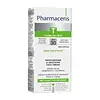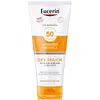What's inside
What's inside
 Key Ingredients
Key Ingredients

 Benefits
Benefits

 Concerns
Concerns

 Ingredients Side-by-side
Ingredients Side-by-side

Water
Skin ConditioningEthylhexyl Methoxycinnamate
UV AbsorberC12-15 Alkyl Benzoate
AntimicrobialDiethylamino Hydroxybenzoyl Hexyl Benzoate
UV FilterPentylene Glycol
Skin ConditioningGlycerin
HumectantCyclopentasiloxane
EmollientCetearyl Alcohol
EmollientEthylhexyl Triazone
UV AbsorberCyclohexasiloxane
EmollientCetyl Alcohol
EmollientPEG-100 Stearate
Methylene Bis-Benzotriazolyl Tetramethylbutylphenol
UV FilterSodium Polyacrylate
AbsorbentCetearyl Glucoside
EmulsifyingDimethicone
EmollientInulin
Skin ConditioningHydroxyethyl Urea
HumectantParfum
MaskingPropylene Glycol
HumectantLonicera Caprifolium Flower Extract
PerfumingAllantoin
Skin ConditioningMandelic Acid
AntimicrobialPolysilicone-11
Decyl Glucoside
CleansingAlpha-Glucan Oligosaccharide
CleansingLonicera Japonica Flower Extract
Skin ConditioningAmmonium Lactate
BufferingBHA
AntioxidantSalvia Officinalis Extract
AntimicrobialGlucose
HumectantSalix Alba Bark Extract
AstringentXanthan Gum
EmulsifyingPotassium Sorbate
PreservativeSodium Benzoate
MaskingWater, Ethylhexyl Methoxycinnamate, C12-15 Alkyl Benzoate, Diethylamino Hydroxybenzoyl Hexyl Benzoate, Pentylene Glycol, Glycerin, Cyclopentasiloxane, Cetearyl Alcohol, Ethylhexyl Triazone, Cyclohexasiloxane, Cetyl Alcohol, PEG-100 Stearate, Methylene Bis-Benzotriazolyl Tetramethylbutylphenol, Sodium Polyacrylate, Cetearyl Glucoside, Dimethicone, Inulin, Hydroxyethyl Urea, Parfum, Propylene Glycol, Lonicera Caprifolium Flower Extract, Allantoin, Mandelic Acid, Polysilicone-11, Decyl Glucoside, Alpha-Glucan Oligosaccharide, Lonicera Japonica Flower Extract, Ammonium Lactate, BHA, Salvia Officinalis Extract, Glucose, Salix Alba Bark Extract, Xanthan Gum, Potassium Sorbate, Sodium Benzoate
Water
Skin ConditioningAlcohol Denat.
AntimicrobialButylene Glycol Dicaprylate/Dicaprate
EmollientButyl Methoxydibenzoylmethane
UV AbsorberC12-15 Alkyl Benzoate
AntimicrobialBis-Ethylhexyloxyphenol Methoxyphenyl Triazine
Skin ConditioningDistarch Phosphate
AbsorbentDibutyl Adipate
EmollientEthylhexyl Triazone
UV AbsorberDicaprylyl Carbonate
EmollientDiethylamino Hydroxybenzoyl Hexyl Benzoate
UV FilterPhenylbenzimidazole Sulfonic Acid
UV AbsorberDiethylhexyl Butamido Triazone
UV AbsorberBehenyl Alcohol
EmollientCetearyl Alcohol
EmollientGlyceryl Stearate
EmollientGlycerin
HumectantGlycyrrhiza Inflata Root Extract
Skin ConditioningGlycyrrhetinic Acid
Skin ConditioningTocopherol
AntioxidantCopernicia Cerifera Cera
EmollientHydrogenated Rapeseed Oil
EmollientCetyl Palmitate
EmollientXanthan Gum
EmulsifyingSodium Stearoyl Glutamate
CleansingSilica Dimethyl Silylate
EmollientPhenoxyethanol
PreservativeHydroxyacetophenone
AntioxidantCaprylyl Glycol
EmollientTrisodium EDTA
Sodium Hydroxide
BufferingSodium Chloride
MaskingParfum
MaskingWater, Alcohol Denat., Butylene Glycol Dicaprylate/Dicaprate, Butyl Methoxydibenzoylmethane, C12-15 Alkyl Benzoate, Bis-Ethylhexyloxyphenol Methoxyphenyl Triazine, Distarch Phosphate, Dibutyl Adipate, Ethylhexyl Triazone, Dicaprylyl Carbonate, Diethylamino Hydroxybenzoyl Hexyl Benzoate, Phenylbenzimidazole Sulfonic Acid, Diethylhexyl Butamido Triazone, Behenyl Alcohol, Cetearyl Alcohol, Glyceryl Stearate, Glycerin, Glycyrrhiza Inflata Root Extract, Glycyrrhetinic Acid, Tocopherol, Copernicia Cerifera Cera, Hydrogenated Rapeseed Oil, Cetyl Palmitate, Xanthan Gum, Sodium Stearoyl Glutamate, Silica Dimethyl Silylate, Phenoxyethanol, Hydroxyacetophenone, Caprylyl Glycol, Trisodium EDTA, Sodium Hydroxide, Sodium Chloride, Parfum
 Reviews
Reviews

Ingredients Explained
These ingredients are found in both products.
Ingredients higher up in an ingredient list are typically present in a larger amount.
C12-15 Alkyl Benzoate is made up of Benzoic Acid and long chain alcohols. It has a low molecular weight.
C12-15 Alkyl Benzoate is an emollient and texture enhancer. Due to its solubility, it is often used in sunscreens to help evenly distribute active ingredients.
As an emollient, C12-15 Alkyl Benzoate helps soften and hydrate your skin. Emollients create a film on your skin that traps moisture within.
This ingredient has been reported to cause eye irritation.
Learn more about C12-15 Alkyl BenzoateCetearyl alcohol is a mixture of two fatty alcohols: cetyl alcohol and stearyl alcohol. It is mainly used as an emulsifier. Emulsifiers help prevent the separation of oils and products. Due to its composition, it can also be used to thicken a product or help create foam.
Cetearyl alcohol is an emollient. Emollients help soothe and hydrate the skin by trapping moisture.
Studies show Cetearyl alcohol is non-toxic and non-irritating. The FDA allows products labeled "alcohol-free" to have fatty alcohols.
This ingredient is usually derived from plant oils such as palm, vegetable, or coconut oils. There is debate on whether this ingredient will cause acne.
Due to the fatty acid base, this ingredient may not be Malassezia folliculitis safe.
Learn more about Cetearyl AlcoholDiethylamino Hydroxybenzoyl Hexyl Benzoate (DHHB) is a chemical UV-A absorber. It is formulated for high UVA protection (320-400 nm).
DHHB is well-liked for:
DHHB has been approved by the EU, Japan, Taiwan, and South America for use up to 10%. Unfortunately, it has not been approved for use in the US or Canada due to slow regulatory processes.
This ingredient is soluble in oils, fats, and lipids.
Learn more about Diethylamino Hydroxybenzoyl Hexyl BenzoateEthylhexyl Triazone is a modern chemical sunscreen that protects from UV-B radiation.
It is the most effective of existing UV-B filters, as it provides the highest level of photo-stable absorption. It protects from the entire UV-B range (280 to 320nm), with it's highest level of protection at 314nm.
Ethylhexyl Triazone is oil soluble, oderless and colorless, which mean it is able to be incorporated into a variety of different formulations.
It is not currently available within the United States due to slow changing FDA regulations. Outside of the US, it is used in formulations at concentrations up to 5%.
Learn more about Ethylhexyl TriazoneGlycerin is already naturally found in your skin. It helps moisturize and protect your skin.
A study from 2016 found glycerin to be more effective as a humectant than AHAs and hyaluronic acid.
As a humectant, it helps the skin stay hydrated by pulling moisture to your skin. The low molecular weight of glycerin allows it to pull moisture into the deeper layers of your skin.
Hydrated skin improves your skin barrier; Your skin barrier helps protect against irritants and bacteria.
Glycerin has also been found to have antimicrobial and antiviral properties. Due to these properties, glycerin is often used in wound and burn treatments.
In cosmetics, glycerin is usually derived from plants such as soybean or palm. However, it can also be sourced from animals, such as tallow or animal fat.
This ingredient is organic, colorless, odorless, and non-toxic.
Glycerin is the name for this ingredient in American English. British English uses Glycerol/Glycerine.
Learn more about GlycerinParfum is a catch-all term for an ingredient or more that is used to give a scent to products.
Also called "fragrance", this ingredient can be a blend of hundreds of chemicals or plant oils. This means every product with "fragrance" or "parfum" in the ingredients list is a different mixture.
For instance, Habanolide is a proprietary trade name for a specific aroma chemical. When used as a fragrance ingredient in cosmetics, most aroma chemicals fall under the broad labeling category of “FRAGRANCE” or “PARFUM” according to EU and US regulations.
The term 'parfum' or 'fragrance' is not regulated in many countries. In many cases, it is up to the brand to define this term.
For instance, many brands choose to label themselves as "fragrance-free" because they are not using synthetic fragrances. However, their products may still contain ingredients such as essential oils that are considered a fragrance by INCI standards.
One example is Calendula flower extract. Calendula is an essential oil that still imparts a scent or 'fragrance'.
Depending on the blend, the ingredients in the mixture can cause allergies and sensitivities on the skin. Some ingredients that are known EU allergens include linalool and citronellol.
Parfum can also be used to mask or cover an unpleasant scent.
The bottom line is: not all fragrances/parfum/ingredients are created equally. If you are worried about fragrances, we recommend taking a closer look at an ingredient. And of course, we always recommend speaking with a professional.
Learn more about ParfumWater. It's the most common cosmetic ingredient of all. You'll usually see it at the top of ingredient lists, meaning that it makes up the largest part of the product.
So why is it so popular? Water most often acts as a solvent - this means that it helps dissolve other ingredients into the formulation.
You'll also recognize water as that liquid we all need to stay alive. If you see this, drink a glass of water. Stay hydrated!
Learn more about WaterXanthan gum is used as a stabilizer and thickener within cosmetic products. It helps give products a sticky, thick feeling - preventing them from being too runny.
On the technical side of things, xanthan gum is a polysaccharide - a combination consisting of multiple sugar molecules bonded together.
Xanthan gum is a pretty common and great ingredient. It is a natural, non-toxic, non-irritating ingredient that is also commonly used in food products.
Learn more about Xanthan Gum